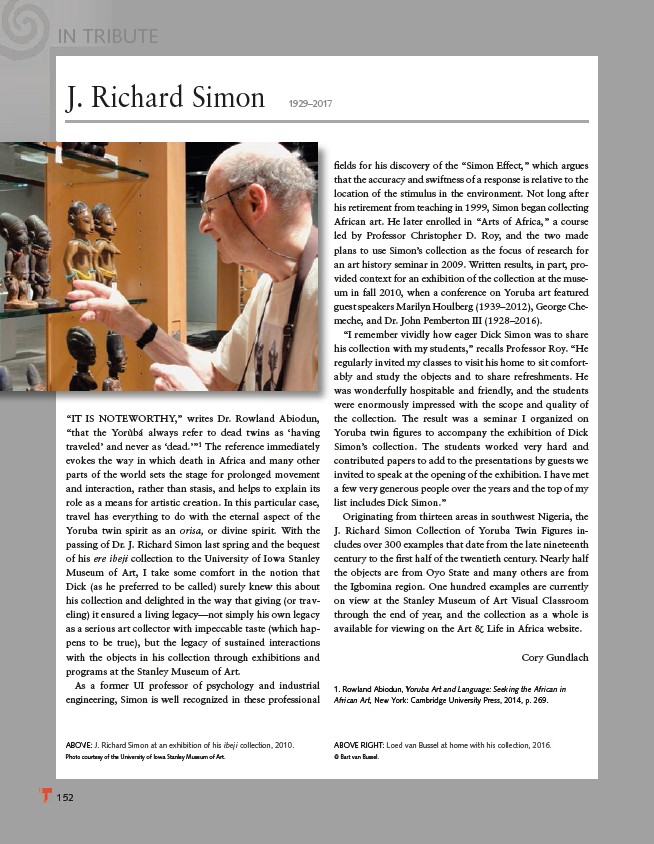
IN TRIBUTE
“IT IS NOTEWORTHY,” writes Dr. Rowland Abiodun,
“that the Yorùbá always refer to dead twins as ‘having
traveled’ and never as ‘dead.’”1 The reference immediately
evokes the way in which death in Africa and many other
parts of the world sets the stage for prolonged movement
and interaction, rather than stasis, and helps to explain its
role as a means for artistic creation. In this particular case,
travel has everything to do with the eternal aspect of the
Yoruba twin spirit as an orisa, or divine spirit. With the
passing of Dr. J. Richard Simon last spring and the bequest
of his ere ibeji collection to the University of Iowa Stanley
Museum of Art, I take some comfort in the notion that
Dick (as he preferred to be called) surely knew this about
his collection and delighted in the way that giving (or traveling)
152
it ensured a living legacy—not simply his own legacy
as a serious art collector with impeccable taste (which happens
to be true), but the legacy of sustained interactions
with the objects in his collection through exhibitions and
programs at the Stanley Museum of Art.
As a former UI professor of psychology and industrial
engineering, Simon is well recognized in these professional
fi elds for his discovery of the “Simon Effect,” which argues
that the accuracy and swiftness of a response is relative to the
location of the stimulus in the environment. Not long after
his retirement from teaching in 1999, Simon began collecting
African art. He later enrolled in “Arts of Africa,” a course
led by Professor Christopher D. Roy, and the two made
plans to use Simon’s collection as the focus of research for
an art history seminar in 2009. Written results, in part, provided
context for an exhibition of the collection at the museum
in fall 2010, when a conference on Yoruba art featured
guest speakers Marilyn Houlberg (1939–2012), George Chemeche,
and Dr. John Pemberton III (1928–2016).
“I remember vividly how eager Dick Simon was to share
his collection with my students,” recalls Professor Roy. “He
regularly invited my classes to visit his home to sit comfortably
and study the objects and to share refreshments. He
was wonderfully hospitable and friendly, and the students
were enormously impressed with the scope and quality of
the collection. The result was a seminar I organized on
Yoruba twin fi gures to accompany the exhibition of Dick
Simon’s collection. The students worked very hard and
contributed papers to add to the presentations by guests we
invited to speak at the opening of the exhibition. I have met
a few very generous people over the years and the top of my
list includes Dick Simon.”
Originating from thirteen areas in southwest Nigeria, the
J. Richard Simon Collection of Yoruba Twin Figures includes
over 300 examples that date from the late nineteenth
century to the fi rst half of the twentieth century. Nearly half
the objects are from Oyo State and many others are from
the Igbomina region. One hundred examples are currently
on view at the Stanley Museum of Art Visual Classroom
through the end of year, and the collection as a whole is
available for viewing on the Art & Life in Africa website.
Cory Gundlach
1. Rowland Abiodun, Yoruba Art and Language: Seeking the African in
African Art, New York: Cambridge University Press, 2014, p. 269.
J. Richard Simon 1929–2017
ABOVE: J. Richard Simon at an exhibition of his ibeji collection, 2010.
Photo courtesy of the University of Iowa Stanley Museum of Art.
ABOVE RIGHT: Loed van Bussel at home with his collection, 2016.
© Bart van Bussel.